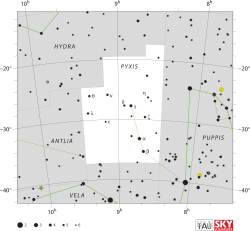| Observation data Epoch J2000.0 Equinox J2000.0 (ICRS) | |
|---|---|
| Constellation | Pyxis |
| Right ascension | 08h 55m 31.56948s[1] |
| Declination | −27° 40′ 54.7315″[1] |
| Apparent magnitude (V) | +4.877[2] |
| Characteristics | |
| Spectral type | A3 IV[3] |
| U−B color index | +0.224[2] |
| B−V color index | +0.130[2] |
| Astrometry | |
| Radial velocity (Rv) | 5.4±0.8[4] km/s |
| Proper motion (μ) | RA: +81.90[1] mas/yr Dec.: −100.43[1] mas/yr |
| Parallax (π) | 13.19 ± 0.77 mas[1] |
| Distance | 250 ± 10 ly (76 ± 4 pc) |
| Absolute magnitude (MV) | +0.67[5] |
| Details | |
| Mass | 1.84[6] M☉ |
| Radius | 1.6[7] R☉ |
| Luminosity | 59[3] L☉ |
| Surface gravity (log g) | 3.77±0.14[6] cgs |
| Temperature | 8,609±293[6] K |
| Rotational velocity (v sin i) | 68[6] km/s |
| Age | 296[6] Myr |
| Other designations | |
| Database references | |
| SIMBAD | data |
Delta Pyxidis (δ Pyxidis) is binary star[9] system in southern constellation of Pyxis. Having an apparent visual magnitude of +4.877,[2] it is bright enough to be visible to the naked eye. Based upon an annual parallax shift of 13.19 mas as seen from Earth,[1] it is located around 250 light years from the Sun.
In Chinese, 天狗 (Tiān Gǒu), meaning Celestial Dog, refers to an asterism consisting of δ Pyxidis, e Velorum, f Velorum, β Pyxidis, α Pyxidis and γ Pyxidis. Consequently, δ Pyxidis itself is known as 天狗七 (Tiān Gǒu qī, English: the Seventh Star of Celestial Dog.)[10]
This is an astrometric binary system, as determined by changes in the proper motion of the primary.[11] The visible component has a stellar classification of A3 IV,[3] indicating it has the spectrum of an A-type subgiant star that is consuming the last of the hydrogen at its core. At the age of around 296 million years,[6] it is 92.5%[3] of the way through its main sequence lifetime and is spinning with a projected rotational velocity of 68 km/s.[6] The star has an estimated 1.8[6] times the mass of the Sun and about 1.6[7] times the Sun's radius. It is radiating 59[3] times the Sun's luminosity from its photosphere at an effective temperature of roughly 8,609 K.[6]
- ^ a b c d e f Cite error: The named reference
vanLeeuwen2007was invoked but never defined (see the help page). - ^ a b c d Cite error: The named reference
sps1966was invoked but never defined (see the help page). - ^ a b c d e Cite error: The named reference
Zorec2012was invoked but never defined (see the help page). - ^ Cite error: The named reference
deBruijne2012was invoked but never defined (see the help page). - ^ Cite error: The named reference
Anderson2012was invoked but never defined (see the help page). - ^ a b c d e f g h i Cite error: The named reference
David2015was invoked but never defined (see the help page). - ^ a b Cite error: The named reference
PasinettiFracassini2001was invoked but never defined (see the help page). - ^ Cite error: The named reference
SIMBADwas invoked but never defined (see the help page). - ^ Cite error: The named reference
Eggleton2008was invoked but never defined (see the help page). - ^ (in Chinese) AEEA (Activities of Exhibition and Education in Astronomy) 天文教育資訊網 2006 年 7 月 17 日
- ^ Cite error: The named reference
Frankowski2007was invoked but never defined (see the help page).
